Colorado Parks and Wildlife has accepted a settlement of $207,000 from American Civil Contractors (ACC) for the accidental fishkill on the Big Thompson River this past March. The settlement, which will be spent restoring fish habitat in the lower Big Thompson will help ensure the river and trout fishing will be brought back to its former glory before the 2013 flood. “Colorado Parks and Wildlife is heartened by the cooperation of ACC, Larimer County, and Central Federal Lands in finding the cause of the fishkill,” said Area Wildlife Manager Larry Rogstad. “While the events leading to the fishkill were unintentional, the outcome was devastating to the rainbow and brown trout fishery in the lower Big Thompson, which prior to the flood was well known among anglers. The fishery is a valuable public resource therefore CPW has been dedicated to verifying what happened, and recovering appropriate compensation for the Big Thompson loss. Everyone involved is pleased that this settlement will go directly back to the canyon, the habitat and ultimately to the fish, right where it should go!”
Although not related in any way, the larger Big Thompson/US Highway 34 project, spearheaded by Colorado Department of Transportation, to rebuild and make permanent repairs to Highway 34 and the adjacent Big Thompson River, has taken note of what happened with the fishkill. The goal of this multiyear project, which started with the recent closure of the highway in the lower canyon, is to rebuild the highway, the river and the canyon in a manner that is ecologically functional, while providing recreational opportunity, and most of all with resilience against future flooding. Since the 2013 flood, CDOT and its consultants, multiple federal, state and local agencies, and canyon residents have been meeting frequently to design and implement the canyon recovery plan between Estes Park and Loveland that will be a showcase of engineering and collaboration. As part of the process agencies involved in the Big Thompson project, including CPW, have been working together to establish a set of best management practices to absolutely minimize chance that a similar event occurs again. Lessons learned from the fishkill have been instrumental in establishing environmental protection on the Big T project.
“The 2013 floods devastated the river habitat which is precisely what ACC was working to mitigate,” stated Randy Maher, ACC President. “Along the North Fork project the team used the natural hydrology of the river to create and restore quality fish structure and repair and enhance 19 acres of riparian habitat so the fish and wildlife will thrive again. We were so excited by what we were creating and were obviously devastated by the loss.”
Restoring the recreational fishery and creating a new road-river interface with long-term resiliency and natural function remains the priority for multiple agencies. According to Rogstad, “river restoration goals in the CDOT project, along with a little help from Mother Nature should bring the fishery back to pre-flood quality.” Along the way, money from the fishkill settlement will be put right back into the river to improve invertebrate and fish habitat that will benefit trout and other species for years to come. Once the road graders have finished the project CPW will sample and tweak the fishery as needed, and ultimately the Big Thompson will be better than ever for people, for wildlife and most especially for the trout.”
For more information on the fishkill, visit: http://cpw.state.co.us/aboutus/Pages/News-Release-Details.aspx?NewsID=5756






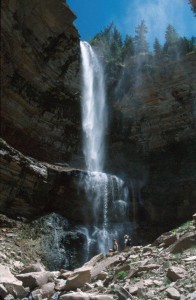

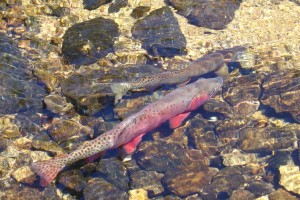
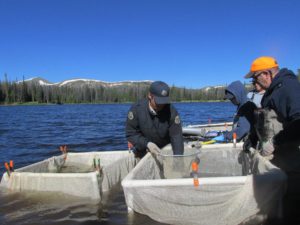 Colorado TU teamed up with Colorado Parks and Wildlife to reintroduce Greenback Cutthroat trout into their native watersheds all along the Front Range. Efforts this past year including spawning
Colorado TU teamed up with Colorado Parks and Wildlife to reintroduce Greenback Cutthroat trout into their native watersheds all along the Front Range. Efforts this past year including spawning 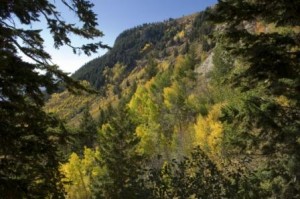
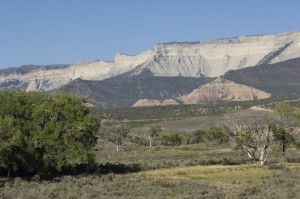 The MLP process is a new tool that promises to address some of that top-down, fragmented approach to public land management. To their credit, the BLM is listening and incorporating suggestions from local ranchers, conservation groups and elected officials into their leasing plan for South Park.
The MLP process is a new tool that promises to address some of that top-down, fragmented approach to public land management. To their credit, the BLM is listening and incorporating suggestions from local ranchers, conservation groups and elected officials into their leasing plan for South Park. The Roan Plateau is home to outstanding big game habitat and unique native trout like those pictured here. Trout Unlimited has been hard at work on the Roan for more than two decades, with many hundreds of volunteer hours invested by the Grand Valley Anglers chapter on habitat protection and improvement projects from instream structures to riparian fencing and replanting. TU also helped install a fish barrier to protect native cutthroat trout habitat being restored by Colorado Parks and Wildlife.
The Roan Plateau is home to outstanding big game habitat and unique native trout like those pictured here. Trout Unlimited has been hard at work on the Roan for more than two decades, with many hundreds of volunteer hours invested by the Grand Valley Anglers chapter on habitat protection and improvement projects from instream structures to riparian fencing and replanting. TU also helped install a fish barrier to protect native cutthroat trout habitat being restored by Colorado Parks and Wildlife. The Thompson Divide (including Thompson Creek pictured here) makes up more than 220,000 acres of federal land in Pitkin, Garfield, Gunnison and Mesa counties and contains some of Colorado's most productive habitat for big game, cutthroat trout and numerous other native species. The area is used by more than 10,000 resident and nonresident big game hunters every year and serves as the headwaters to some of Colorado’s most popular fisheries including the Roaring Fork, North Fork of the Gunnison, and Crystal River.
The Thompson Divide (including Thompson Creek pictured here) makes up more than 220,000 acres of federal land in Pitkin, Garfield, Gunnison and Mesa counties and contains some of Colorado's most productive habitat for big game, cutthroat trout and numerous other native species. The area is used by more than 10,000 resident and nonresident big game hunters every year and serves as the headwaters to some of Colorado’s most popular fisheries including the Roaring Fork, North Fork of the Gunnison, and Crystal River.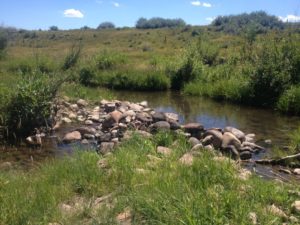 A small creek in southwest Wyoming just got a big upgrade. This November, a push-up style diversion was improved to a fish-friendly rock vane structure with a head-gate, reconnecting approximately 6 miles of habitat for the native Colorado River cutthroat trout that reside there. This project was unique in that it all began with the local school. Trout Unlimited partnered with the McKinnon Elementary School to study their home water, the Henry’s Fork River, through the Adopt-a-Trout program. This particular program involved tagging Colorado River cutthroat trout with telemetry tags and tracking their movement from 2014-2016. The students each got to “adopt” their own fish and follow it throughout the year. They learned a variety of river ecology lessons, including fish anatomy, macroinvertebrate identification, applying the scientific method, riparian ecosystems and many more. They also had to map where their fish moved using Google Earth.
A small creek in southwest Wyoming just got a big upgrade. This November, a push-up style diversion was improved to a fish-friendly rock vane structure with a head-gate, reconnecting approximately 6 miles of habitat for the native Colorado River cutthroat trout that reside there. This project was unique in that it all began with the local school. Trout Unlimited partnered with the McKinnon Elementary School to study their home water, the Henry’s Fork River, through the Adopt-a-Trout program. This particular program involved tagging Colorado River cutthroat trout with telemetry tags and tracking their movement from 2014-2016. The students each got to “adopt” their own fish and follow it throughout the year. They learned a variety of river ecology lessons, including fish anatomy, macroinvertebrate identification, applying the scientific method, riparian ecosystems and many more. They also had to map where their fish moved using Google Earth. Using two years of the Adopt-a-Trout data and an instream flow study that TU conducted on Beaver Creek, a major tributary, we discovered that there was a push-up dam near the confluence to the Henry’s Fork that was not allowing fish passage for a critical part of the year. None of the students’ fish were able to pass that point during the summer months. So, TU collaborated with the Lonetree Ranch to develop a fish-friendly diversion that would still allow them to receive their irrigation water, but would allow for fish passage during low flows. A head-gate was also installed so that they could turn the ditch off when they no longer needed to irrigate, leaving more water instream for the trout. Thanks to the funding provided by the Wyoming Landscape Conservation Initiative, the Wyoming Wildlife Natural Resource Trust and the Natural Resources Conservation Service, the project was able to be completed November 2016.
Using two years of the Adopt-a-Trout data and an instream flow study that TU conducted on Beaver Creek, a major tributary, we discovered that there was a push-up dam near the confluence to the Henry’s Fork that was not allowing fish passage for a critical part of the year. None of the students’ fish were able to pass that point during the summer months. So, TU collaborated with the Lonetree Ranch to develop a fish-friendly diversion that would still allow them to receive their irrigation water, but would allow for fish passage during low flows. A head-gate was also installed so that they could turn the ditch off when they no longer needed to irrigate, leaving more water instream for the trout. Thanks to the funding provided by the Wyoming Landscape Conservation Initiative, the Wyoming Wildlife Natural Resource Trust and the Natural Resources Conservation Service, the project was able to be completed November 2016.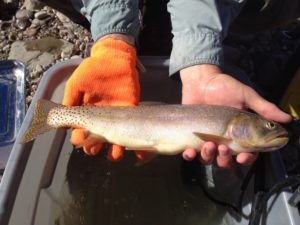 This is just the first of many projects that will be done along Beaver Creek to benefit native trout. Over the next year, the McKinnon students will be assisting with vegetation planting and monitoring on several sections right above the diversion to provide better cover and reduce stream temperatures during the summer months. Projects like these are not only reconnecting populations of native trout, but reconnecting kids to “their” fish and river.
This is just the first of many projects that will be done along Beaver Creek to benefit native trout. Over the next year, the McKinnon students will be assisting with vegetation planting and monitoring on several sections right above the diversion to provide better cover and reduce stream temperatures during the summer months. Projects like these are not only reconnecting populations of native trout, but reconnecting kids to “their” fish and river.
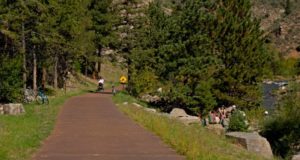 The trail includes not only 3 miles of a paved multiuse trail, but features 3 bridges, 6 new formal river access points and multiple overlooks and boulder seating areas. Other improvements include two new parking lots and an expanded parking lot and restroom at Mayhem Gulch. The parking lots are a key component to bringing a new types of visitor to Clear Creek Canyon; cyclists, hikers and walkers.
The trail includes not only 3 miles of a paved multiuse trail, but features 3 bridges, 6 new formal river access points and multiple overlooks and boulder seating areas. Other improvements include two new parking lots and an expanded parking lot and restroom at Mayhem Gulch. The parking lots are a key component to bringing a new types of visitor to Clear Creek Canyon; cyclists, hikers and walkers.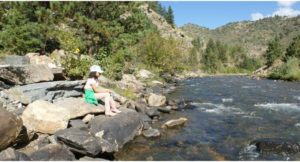 t was encouraging to see extended families walking the trail, leaning over the guardrail at an overlook pointing to trout rising behind a large boulder. Joggers pushing strollers paused at the overlooks on the bridges to catch their breath. Cyclists were numerous and one group took advantage of the informal boulder seating areas to stop for a picnic lunch. There were crowds of climbers at all of the popular areas, and fisherman were ducking in and out of the willows along the banks.
t was encouraging to see extended families walking the trail, leaning over the guardrail at an overlook pointing to trout rising behind a large boulder. Joggers pushing strollers paused at the overlooks on the bridges to catch their breath. Cyclists were numerous and one group took advantage of the informal boulder seating areas to stop for a picnic lunch. There were crowds of climbers at all of the popular areas, and fisherman were ducking in and out of the willows along the banks.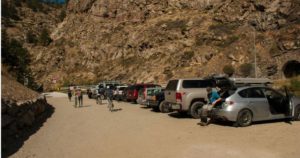 My overall impression of the trail was extremely positive. The materials used through compliment the character of the Canyon. The improved parking areas provide additional spaces and greatly improve visitor safety and the new signage is clear and concise. The biggest improvement; however, is the trail. It allows visitors to disconnect from Highway 6 and truly immerse themselves in the Creek, the Canyon, and the Landscape.
My overall impression of the trail was extremely positive. The materials used through compliment the character of the Canyon. The improved parking areas provide additional spaces and greatly improve visitor safety and the new signage is clear and concise. The biggest improvement; however, is the trail. It allows visitors to disconnect from Highway 6 and truly immerse themselves in the Creek, the Canyon, and the Landscape.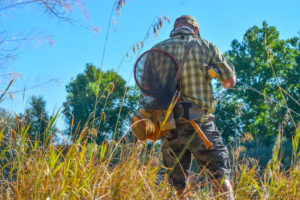 In 2015 Colorado Gives Day raised more than $28 million in funds and supported over 1,800 non-profits. In 2010, Community First Foundation created Colorado Gives Day as an annual statewide movement to celebrate and increase philanthropy in Colorado through online giving.
In 2015 Colorado Gives Day raised more than $28 million in funds and supported over 1,800 non-profits. In 2010, Community First Foundation created Colorado Gives Day as an annual statewide movement to celebrate and increase philanthropy in Colorado through online giving.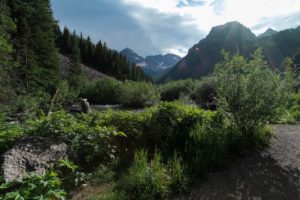 We have always prided ourselves on our ability to work in a bipartisan manner. Since Trout Unlimited was founded in Michigan in 1959, the organization has existed—and grown—through 11 different presidential administrations (29 years Republican, and 28 years Democrat). For example, several clear opportunities exist for us in the new Congress and with the new Trump Administration; these include Good Samaritan legislation to help clean up abandoned mines, a higher priority on water infrastructure improvements, and public land renewable energy legislation.
We have always prided ourselves on our ability to work in a bipartisan manner. Since Trout Unlimited was founded in Michigan in 1959, the organization has existed—and grown—through 11 different presidential administrations (29 years Republican, and 28 years Democrat). For example, several clear opportunities exist for us in the new Congress and with the new Trump Administration; these include Good Samaritan legislation to help clean up abandoned mines, a higher priority on water infrastructure improvements, and public land renewable energy legislation.
